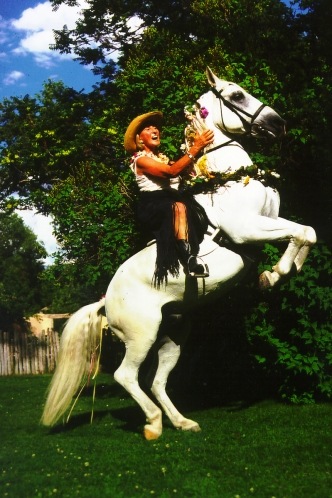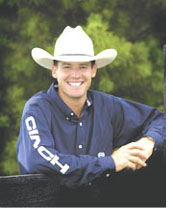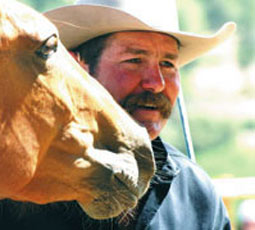The Mindful Horse
And I watched my Pat Parelli videos again last week, too.
And as readers know, I’m a student and employee of Linda Tellington-Jones.
I’ve been thinking about those round pen sessions between new horse and trainer. Neither has seen the other before, and it’s a neck-and-neck race for dominance and submission. You’ve all seen them. They get you on the edge of your seat every time. In its extreme form, The Race To the Horse comes to mind.
I attended a Clinton Anderson Clinic in Ogden Utah in 2005. It was so cold we turned blue, but I went both days, and stayed all day. And boyo, does he get the job done. At first, long before I knew there was another way, I was totally enamored of his Aussie accent, his long legs and his, shall we say, confidentway with horses. Now when I watch, I still admire some of his techniques, but I cringe at the dominance inherent in his manner, and the lack of time he allows the horse to stop and think. If I watch the horse carefully, I can feel the rapid heartbeat and lack of true understanding in his heart. He sees what Clinton wants him to do, and, like the intelligent animal he is, he does it. But he does it because he has NO CHOICE. The sheer dominance of the human being he is corralled with allows no time for a true partnership to develop. He also does it because he has been allowed NO TIME TO THINK. When Clinton Anderson says,
Make the right thing easy and the wrong thing difficult,
he allows no time for the horse to pause and come to the conclusion himself. Clinton Anderson’s entire basis for training is all about “Yes Sir, yes Ma’am” and gaining RESPECT. Moving the horse’s feet gains that respect. This is a useful thing and a big plus in the safety department, especially for the novice rider. It’s just that there’s so much testosterone involved. Hasn’t he noticed that the majority of pleasure riders are female? Where are most of us going to come up with that much masterly manliness in the face of a barging horse? No novice I know could accomplish what it takes to master Clinton’s methods and get that respect on the ground and in the saddle, including myself. It takes time. And in that time, you have lost something valuable. The horse’s trust and partnership, and his ability to pause and think for himself.
Pat Parelli always won my respect and admiration by talking about partnership with the horse. In his videos, he stresses
always allowing the horse to be right,
and giving him adequate time and physical space (this is important when you have a scary horse) to make the desired decision. Longeing a horse toward a tree comes to mind. After two or three tries, the horse comes to understand that he is to avoid the tree and stay on a semi-circular path, because he gets no slack to go around the tree. Pat does not run screaming at the horse, or yank the lead to pull the horse from behind the tree, but merely allows the horse time to work out the issue on his own.
To develop the horse’s responsibility rather than making him a mindless puppet.
This is confidence building at its best. That’s progress toward building a mindful, thinking partner to ride with. Like others, however, I have some amorphous problems with the Parelli method. And no, this does not include personal problems with the Parelli “PR Machine.” As far as I’m concerned, he can suck in as many riders as he wants with that enormous and charming ego as long as they learn something. Heck, I bought some videos. I’m just as guilty of getting trapped in the PR buzz as anyone else. I’ve learned a lot from him, though probably not in the way that he intended. Admittedly, my problem could come from my own ignorance and lack of exposure to the right kind of horsepeople. But I have never yet seen a Parelli student whose horse stood quietly under saddle, and was able to walk, trot, canter and gallop according to his rider’s wishes, or make safe and sane transitions among gaits. But they were very good at moving that green ball around the round pen. Again, probably my lack of exposure to the trainees. If you happen to be reading this and you are one, please feel free to put me solidly in my place. In fact, I really welcome this. I want to learn more.

Linda Tellington-Jones at her Wedding to Roland Kleger. Photo ourtesy Gabrielle Boiselle Edition Boiselle
Time and time again, I have heard Linda Tellington-Jones decry the use of longeing as a horsemanship tool, reminding us to,
Have the grace to stop running your horse around in circles and allow him time to stop and think about what you are asking him to do.
Like Pat Parelli, Linda is a founding member of the Anti-Longeing Movement. To her, it just doesn’t make sense to run the horse around in circles until he is so exhausted he cries “Uncle” and turns in defeat, head down, to face you. Linda would rather make friends. Though she does not refer directly to mindfulness, Linda’s training method, the Tellington TTouch Equine Awareness Method, stresses, you guessed it,awareness on the part of both horse and rider/ground trainer. And the good thing is, any idiot can do it. If this were not true, then I would not be writing about it, because I amany idiot.
At every stage of training, T.T.E.A.M. is all about the pause. The pause to allow the horse to think and make the desired decision to either stop, turn, move in the right direction, get the right lead, whatever the rider is asking for. And I stress asking. Never is there a yank on the rope or an aggressive switch of the whip. Linda’s Playground for Higher Learning, a kind of gymnasium for horses, can be set up in under an hour in any ring. It is worked in hand and under saddle, with the same goal in mind: a horse in hand or beneath you who is capable of independent but parallel thought. A thinking partner.
I’ve been lucky enough to see that the results of working the Playground for Higher Learning translate to under saddle and outside the ring. Because of the added benefit of Tellington TTouch and its effects on the brainwave patterns of the horse, his ability to learn calmly and to remember what he has learned is significantly enhanced. You don’t have to carry the green ball outside the ring and start over.
What about when you are faced with a monster of a horse you can’t handle this way, you ask? (First of all, I’m not talking to trainers here. I have no business doing that. If you’re the average rider, like me, and dealing with your own horse, who proves too difficult or dangerous to handle or ride, get a new one, but not before you find a safe and permanent home for the one who’s too much to handle.) Being a T.T.E.A.M. practitioner-in-training only, I can’t answer this question with any authority. My advice, based on hours of watching T.T.E.A.M. professionals do this, is, get help, the same way you probably would in any case. I’ve seen pros double and triple team a scary horse, TTouching for trust until the “monster” was drooling in relaxed delight. This does not mean that the horse became a marshmallow in the next steps in training, but they had something to fall back on when he became unruly again. And each time they would fall back on it, a little it more trust and relaxation developed until the horse understood that there was no battle for dominance. Over the course of even just an hour, a horse would gradually come to understand what was being asked.
“Stop and think. There’s nothing to fear. No equine dominance model is being used here. We won’t insult your intelligence by trying to fool you into thinking we are horses. Let’s just be friends. and try some fun stuff.”
Before you know it, all this play on the ground and under saddle turns into a partnership with true mindfulness on the part of both horse and rider.
I can’t imagine a safer, more satisfying and fun equine partner than a mindful one.
I am interested to know what readers think of the most popular horse trainers out there. And why. Where have you gotten your most trusted methods?
Comment
-
Comment by Donna Douglas on August 23, 2010 at 9:24am
-
My horses have always been the very BEST trainers!
-
Comment by Jackie Cochran on August 22, 2010 at 9:29am
-
I found a lot of what I needed to learn about horses from the books of Vladimir Littauer (Forward Seat) over 45 years ago, long before the horse-taming/training started as a spectator sport. I read everyone, and 40 years ago I got my first horse, who was my main teacher. I still read a lot of horse books, and I consider a book to be a good one if it has two or three things in it that really improve my performance (not many books like that, but I've been reading them for 49 years!) I do not learn very well from videos and demonstrations, I have MS and it is hard for me to learn like that as I have a hard time keeping attention and concentrating.
I do not like seeing horses with "slave eyes". I do not enjoy seeing the process of getting the horse to the point he has "slave eyes". Out of the three people mentioned in this post I would go with Linda Tellington-Jones over the other two. I have been following Linda with interest ever since I first heard about her Pacific Coast Horsemanship school, in fact I got my copy of Xenephon from there in the emid 1960's. I do not use her methods, basically because, however slowly it may happen, I gently persuade my horses to do what I want (I call it seducing them, lots of praise!) Linda had not come out with her methods when I started riding seriously, she was still in endurance riding back then.
My horses have never had slave eyes.
Lunging in the Forward Seat method, just a cavesson, lunge line and lunge whip, seeks to teach the horse voice commands, teaching the horse the first basics of the various speeds withing a gait, as well as getting the horse more physically fit before the weight of the rider is put on his back. No side reins, the horse is free to move his head as needed, and so learns to keep his balance in the circle. When I could still do it lungeing served me well in training.
The other big influence in my riding life was Udo Burger, reading his "The Way to Perfect Horsemanship" I finally learned how exactly to time my aids, but this happened only 20 years ago. Up until then, Littauer and the Forward Seat enabled me to train calm, free striding, cooperative horses, even if the horse had been previously ruined.
My big three--Littauer, Caprilli, and Udo Burger, all through their books.
My best human teacher from the start--Kay Russel at North Forks School of Equitation, who taught me how to ride Forward Seat. My best human teacher now--Debbie Campbell at Brandywine Springs South stable, who really helps me refine my body and will not let me use my MS as an excuse to ride badly.
So, if your horse has "slave eyes" I will not watch you or your videos. If you have a book I may read it. I will only use new techniques that fit within the Forward Seat philosophies, and if I can't get it to work the first three times I use it I go back to Littauer, as he has never failed me yet.
-
Comment by 4XChestnut on August 21, 2010 at 11:52pm
-
It's a pity, but the thing that sticks out of your comments for me is "...Linda is a founding member of the Anti-Longeing Movement. To her,it just doesn’t make sense to run the horse around in circles until he is so exhausted he cries “Uncle” and turns in defeat, head down, to face you. " And yet that is not the point of your blog. I see the same thing in so many places - the various natural horsemen, barefoot or new types of shoe advocates, tack inventors, and so on. This broad strokes painting one thing as "bad" tells me that the person advocating for a new thing (be it training method, management method, equipment or what have you) doesn't really have confidence in or lacks understanding of what they are promoting. There is a fear that the new thing isn't really as good as it's hyped up to be. A ridiculous video comes to mind - it was on a website selling a new style of blanket and the video showed someone pretending to have trouble putting a normal turnout blanket on a horse - the point being to prove that normal blankets were awkward and difficult to handle. Certainly there is a marketing strategy to compare and contrast the new product with the old, and generally the bigger the contrast the better, but when taken to the extreme of finding the worst possible example and then suggesting that is the norm it invalidates the comparison to a large extent.
I have taken bits and pieces from various trainers and training methods to find what works for me. I have developed some of my own ideas further and no doubt come to the same conclusions as many others in some areas. I do think Parelli has some valuable information presented in an easily accessible format, but that information is lost in a sea of irrelevance and propaganda decrying all other methods as inherently "Bad". The novice has no way of knowing which bits are worth knowing. Lyons, Roberts, Zettl, even some Irwin and Tellington-Jones influences can be found in my techniques, as can many traditional methods including longeing. I think you could have made your point without painting longeing as "bad" and distracting from the point.
As I teach my students I come to see more and more just how subtle the distinctions in riding really are. I am always reminding my students to "let go" as in give the aid and release to give the horse a chance to respond before asking for more if the response wasn't enough. And yet letting go isn't a big obvious thing because we need to let go without dropping the horse, to give him a chance to respond without abandoning him.
Longeing to wear a horse out isn't the only use of the method. A horse can be given the chance to respond while on the longeline, to think, to learn, to relax into the exercise, to bring their focus to the partnership with the human.
The hardcore Parelli people's horses I've seen tend to have bored, "I am enduring this" expressions during the Parelli sessions. The ridiculous and impractical exercises ensure I won't bother getting into Parelli, but I have taken and use some of the valuable bits and pieces that I've gleaned from the system. I will not paint the whole system as valueless. I have been a spectator at dressage shows and decided that if I had to make my horse go in that fashion, I would never even try to get to that level, but then I've seen the truly beautiful and harmonious partnerships and stick with dressage with that kind of partnership in mind. And when my horse and I mesh in those moments of pure partnership does it matter that some Parelli, or Zettl, or longeing helped us arrive at that point?
The Rider Marketplace
International Horse News
© 2025 Created by Barnmice Admin.
Powered by
![]()
-
Quick Links
- Horse Blogs
- Horse Forums
- Horse Videos
- Horse Photos
-
Sister Sites
- The Rider Marketplace
- The Rider
- Equine Niagara News
-
Helpful Links
- Advertise With Us
- Barnmice Tour
- Feedback
- Report an Issue
- Terms of Service
© Barnmice | Design by N. Salo


You need to be a member of Barnmice Equestrian Social Community to add comments!
Join Barnmice Equestrian Social Community